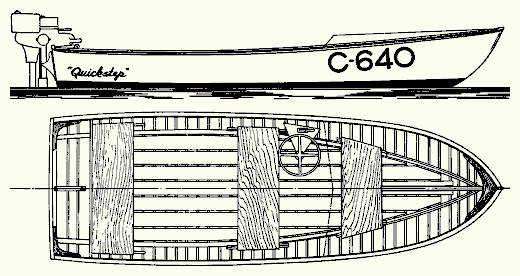

"THE first requisite of any practical boat is safety, the second comfort, and the third speed. Consequently, where the designer has observed this succession of requirements he has produced a serviceable and seaworthy craft; where he has violated it by putting speed first the boats have been either failures or a disappointment in performance." This, written by Edson B. Shock in 1906 is, in my opinion, as applicable and true today as it was then.
In preparing the design of little Quickstep every effort was made to produce a boat that, as Mr. Shock has written, is safe, comfortable and fast. She will surely be able and comfortable, as a glance at her sections will show. And she will be safe. Every precaution has been taken to produce a practical boat, not a freak nor impractical one. As for her speed, I believe she will come close to record speeds approaching 45 m.p.h.

The rules prepared by the American Power Boat Association, by which Stock Utility Outboard Classes are governed, were of great assistance in producing a sensible utility type outboard hull. A list of various classes is shown with the "Maximum Motor Displacement" and the "Minimum Hull Weight" for each class. I selected Class CU (30 cubic inch engine displacement) because it makes a boat large enough for family use, as well as having sufficient power to slide along at a good clip.
So, Quickstep emerged from our drawing board: based on experience gained on many previous successful designs and governed by the excellent rules of the American Power Boat Association.
To quote my father, an old hand at preparing designs and writing about them; and long familiar to the many readers of MoToR BoatinG, "lay the lines down full size, stick very close to the design and you will have an excellent example of a comfortable and fast boat." And that is sage advice, I'm sure.
Quickstep is a light boat. She has been designed to weigh 212 pounds when completed, without engine. This is a little over the minimum hull weight specified for the Class CU rules.
As shown in the outboard runabout, Walter Piel, in a recent issue of MoToR BoatinG, a water-tight bulkhead is installed forward of the transom. This feature, I believe, should be followed in all outboard boats, runabouts, cruisers and otherwise, because of the low cutout required to take the engine. The steering wheel may be placed directly on the center line, or on one side as I have shown it. It is shown on one side to accommodate a mechanic crew, which is allowed in the governing rules of the U. O. R. C.
Three flotation tanks are secured by canvas straps under each thwart. They contain a total of 2.26 cubic feet which is more than enough to float a Class C engine of 30 cubic inches and weighing 115 pounds. The hull will float naturally.

The ample flare forward, with relatively fine waterlines, will provide a dry boat; this same flare and fineness will assure her being easy in choppy water. The continuous flare, from bow to stern, will create greater displacement as the hull heels and therefore she will be stiff and also good on turns. The long, flat run of all her buttock lines and the slight reverse in these, combined with flat sections from station 7 aft, will lift her nicely to a level running position at high speed. And at low speeds her ample displacement will provide a boat suitable for family use in comfort.